What is "frustration pen"? Let’s first understand the nature of the side striker
1.The nature of the side striker
We already know that the essence of the sharp forward line is a series of dots, so what is the essence of the side forward line?
Xiang Feng's handwriting:
If you press the tip of the pen on the paper, the marks you get will be like this, very similar to the marks of an electric iron used to iron clothes.
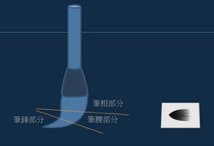
The two ends of it are different: one end is the tip of the pen, where the vellus hairs gather, and the other end is the trace close to the waist of the pen, where the vellus hairs are arranged wider. When the brush is lowered from the paper with the side edge, an iron-shaped point is obtained. When the side edge runs, this Click to move to form a side strike line.
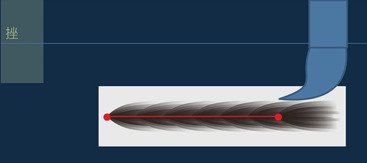
Let's zoom in and take a look. When writing the side strike line, it's like we iron clothes, pulling the iron to form a line.
It should be noted that this iron moves backwards, that is, the pen waist goes first and the pen tip follows. When the pen movement stops, the tail is the trace of the pen waist, which looks like broken wood, so it is called a broken pen.
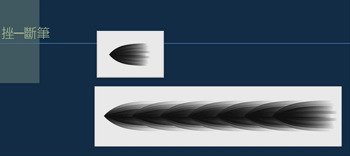
Has the nib reached the end? No, this is an important characteristic of the winger. The tip of the pen only covers the distance between the two red dots and is still a short distance away from the tail. This short section is equal to the length of the stroke you press.
2. Frustration pen
A series of dots are arranged in the sharp edge line. This movement is called Qi Feng. The side strike line arranges this iron-shaped point. What is this action called? The action of moving the pen from the side is called the pen setting in Jiuyong.
"Yutang Forbidden Scripture" says: "The second is to set back the pen, which is to advance quickly by hitting the front. It can be used for the next three points." Here are also three sentences. The first sentence is a name, the second sentence is a definition, and the third sentence is an example. Let me explain it to you sentence by sentence.
The first sentence: The second is to set back the pen. "Frustration", "Shuowen Jiezi" says: "Frustration means to destroy." Duan Yucai quoted from "Kaogongji" note: "Frustration means to break." In spoken language, "Frustration" is often used together with "Zhe". "Frustration" means progress, stopping, or interruption. You can understand the meaning of frustration by thinking about the terms used in daily life. Such as a contusion, which is different from a cut. Cutting is a downward force, and setback is a horizontal pushing force.
The second sentence is "It is also to advance quickly by taking advantage of the front." The meaning of "endure" is "push" in Zhang Zhan's note in Liezi. "Zhengzi Tong" says that it has two meanings: "In dialect, Qianjin is called Pai, but in modern common people, all things that are similar are called Pai." To push forcefully is "Pai", which is the basic meaning. Frustration means strong and fast strokes.
The third sentence says: "Use all the following three points." This is obviously what "Zhengzi Tong" means by saying "all things that are similar are said to be close". Because the stroke pen is fast, it can be used to write repeated and continuous dots and dashes. As shown in the three points below, you can use the setback quickly and continuously.
It should be noted that "three points below" is just an example. It does not mean that only three points can be written. One, two, four, or other dots can also be written with a pen. Are there any practical examples of using frustration in the next three points?
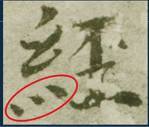
have. The word "经" in Chu Suiliang's "Yin Fu Jing" includes the following three points. This is an ink pad. You can clearly see that the next three points end with broken pens. This is frustration.
In short:
Brushing is to use the technique of side sharpening (or vice-pen).
The lines written with a flat pen are characterized by a broken-like shape at the end.
The brushing pen advances faster and can be continuously brushed.
3.Wang Xizhi’s frustrated pen
Frustration pens are widely used and the reason is very simple. A brush has two edges, forming two lines: a sharp edge line and a side edge line. Calligraphy relies on these two lines to express calligraphy. The pen is straight and the writing is sharp. The center of the pen is curved, which is the side strike line.
3.1 Does Wang Xizhi write with a negative brush or not?
He has a famous work "Lanting Preface". There are a lot of pens among them. Let’s look at the horizontal strokes first.
Look at the word "with". What the red circle shows is that the tail of the horizontal stroke is broken.
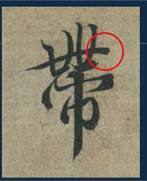
Some pens have neat tails, while others have uneven forks. It doesn't matter, they are all pens.
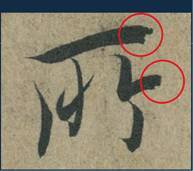
3.2 Use a flat pen to write a vertical line
You can also use a vertical pen to write with a flat pen. Note that your wrist is pointing to the left at this time.
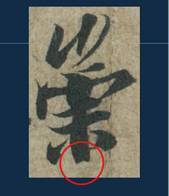
In "Lanting Preface", one vertical stroke is often very heavy, and it is often written in three strokes.
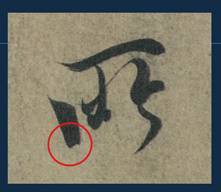
The left side of the word "Suo" is also a three-point stroke, which complements the S-shaped vertical stroke on the right. The left side is affirmative with a pen, while the right side is light and agile.
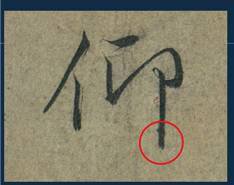
This is a pen stroke, done very lightly and carefully.
3.3 Write with a pen
Let's talk about the Nabi. Wang Xizhi often used a frustrated brush when writing Nabi.
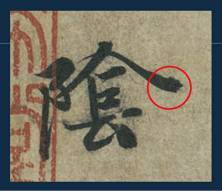
This kind of stroke is an oblique stroke, which is called "甔[zhé]" in calligraphy, which is the eighth method of the eight methods of Yongzi.
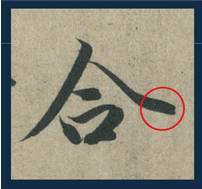
It is not necessary to have a sharp point to close the brush. Many of the brushes in "Lanting" are closed with a flat brush.
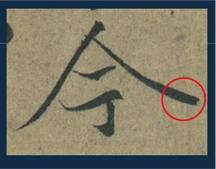
This time too, it came down very quickly.
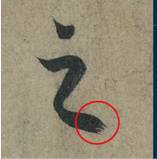
The last stroke of the character "Zhi" was originally a very long stroke, but now it has been shortened.
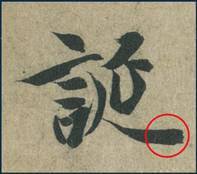
This is Pingna, which is called "wave" in calligraphy.
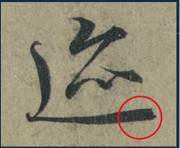
Very gentle waves, also known as "roaming fish".
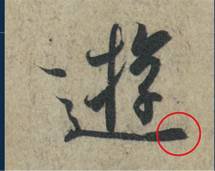
You see, this "roaming fish" is also collected with a pen.
3.4 Write a little with a pen
You can also write a little with a flat pen.
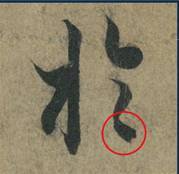
This is the frustration point of the wrist to the left.
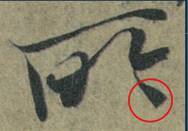
This is the point of frustration of the wrist to the right.
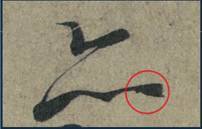
This is a horizontal setback.
How about it? Do you have an impression of Wang Xizhi's brushstrokes now?
4. Frustration of other calligraphers
For example, Zhiyong, the seventh generation grandson of Wang Xizhi. Let me take the ink notebook of Zhiyong's "Zhencao Thousand Character Essay" as an example.
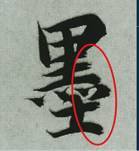
This ink character has many horizontal strokes, all ending with a down stroke.
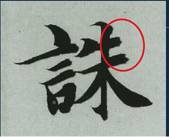
This is also true, Fou Bi is very clear.
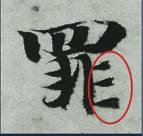
The last three small horizontal lines of the word "sin" are the same as the next three dots. They are continuous and repeated actions. They can be processed with a pen, which is faster.
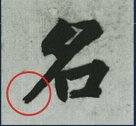
This is a stroke written with a pen, and a stroke is written with a stroke, which is relatively rare.
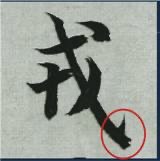
This is the art of writing with a flat pen, because the tip of the pen does not reach the end. So that hook is also a little higher.
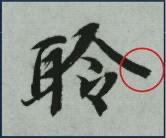
"Listen", a very beautiful setback.
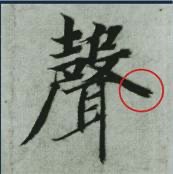
For this "sound", if you use a normal stroke, the left and right sides will be too open. Just use a pen instead.
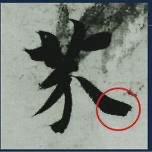
This pen is thick, strong and heavy.
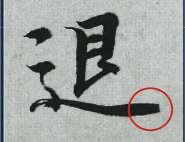
This is also a wandering fish, ending with a setback.
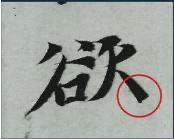
This is a long point, or counterattack, and the strokes are square and clean.
Chu Suiliang, a famous official in the Tang Dynasty and a great calligrapher, I use his large calligraphy "Yin Fu Jing" as an example.
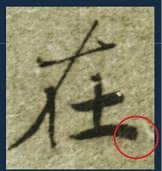
The word "zai" has three horizontal strokes with different endings. The last horizontal stroke was made with a flat pen.
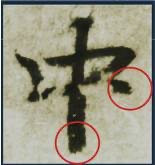
"Zhong", both horizontal and vertical strokes, are both used.
Wen Zhengming, a calligrapher of the Ming Dynasty and the leader of the Wu School of calligraphy and painting. I use his "Poems on Traveling to Tiger Hill" as an example.
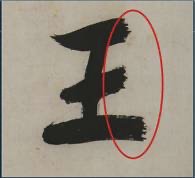
You see, the three horizontal strokes of the word "王" all end with a down stroke. In his later years, Wen Zhengming's writing style was sophisticated and powerful.
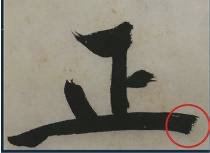
The word "zheng" is long, horizontal and depressed, which is just right.
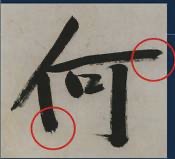
Both horizontal and vertical strokes are written with a flat pen. The flexibility of this pen should be quite good.
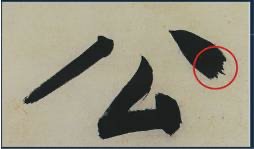
The word "公" is changed to a strong dot. Flick your wrist very steadily from right to left.
Wu Changshuo was a great artist from the late Qing Dynasty to the Republic of China. The leader of the Shanghai School of Painting. His masterpiece of calligraphy is Shiguwen with personal characteristics.
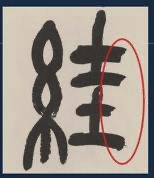
When he writes horizontal strokes, he often ends with a flat stroke, and he has a characteristic: the upper corner of this stroke is often more protruding than the lower corner.
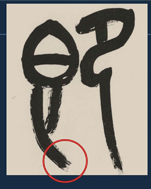
Even though the brush was dry and his wrist strength was strong, he was still very successful.
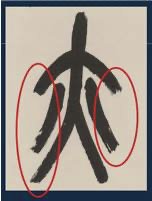
Not only can he stroke the pen to the right, but he also has no problem turning it to the left.
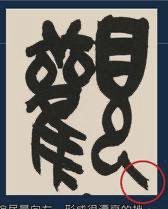
The setback in the red circle is also his characteristic. When closing the pen, the wrist should be turned to the left as much as possible, forming a very beautiful setback.
When practicing brush strokes, start with thicker lines so that you can easily see the effect. So after writing, squat first. Then pull it over quickly, push it, and that's it. You see the effect, this is a brush stroke.
It should be noted that many people unconsciously add a squat at the end. When he was writing, he actually wrote it very well, but in the end he added a squat. If you squat more and more, the ink will come out. As soon as you press it out, the effect of the tail breaking at this place is gone. So you have to note that it's completely flat.
Well, you can also try a straight line. After writing, squat down, and then pull straight, it will be straight. This is a straight setback, so you can also write it diagonally. For example: we write a setback point. After lowering, squat, and then pull, this is the setback point. One click,








